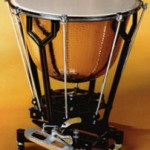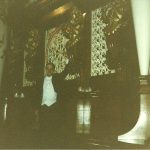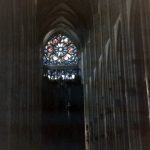My Musical Career|Part Thirty-Five
The Year 1988 – Part One
As mentioned in my previous post, Part Thirty-Four, 1987 was a seminal year in my personal musical development and that of the Oslo Philharmonic Orchestra and its then-chief conductor, Mariss Jansons. What with the increase in touring, the change of recording labels and a higher international profile, all of us were embarked on a new chapter in all of our histories. Just think of it…touring Italy, Spain, appearing at the Festival Maritime d’ete in Rouen for the first time, and touting the USA for the first time in fourteen years was a huge step for all of us in the orchestra. Then there was the recording – going from one or two recordings a year to three to four – a necessity in building up a repertory that would be marketed – was another big thing.
Then, of course, was there was the switch from plastic to calf heads which opened a new world for me in terms of getting a warmer, rounder sound.
When I think back on it all, and turn the page to the year 1988, it turns out that 1988 was almost as eventful. There were three recordings for EMI that year – Prokofiev’s Romeo and Juliet Suites 1 & 2 in January; Mussorgsky’s Pictures and an Exhibition, Night on Bald Mountain and Prelude to Khovanschina in August; and Dvorak’s New World Symphony and Smetana’s The Moldau (Vltava) from “Ma Vlast” in November. Then there was the touring – a quick trip to London for a series of concerts, including one at the Barbican, our second visit to the Festival Maritime in Rouen in June, and the orchestra’s (and mine) first ever visit to Japan – a two week tour in November.
In addition, the year 1988 saw the completion of the purchase of a set of Light Metropolitan B timpani with the delivery of a 31 inch pedal-tuned drum in the spring. We started out with the middle pair in the late summer of 1985, added a 31 inch Continental Chain in the early fall of 1986, and a 24 inch Met B in the spring of 1987. By that time, we decided on ordering the 31 inch as well, and took delivery of that instrument in May 1988, just in time for our third trip to Rouen.
Our Metros
Let me take a moment to digress for a second, and pay tribute to Marshall Light and the American Drum Manufacturing Company. Though nearly three decades have passed since we completed our order, I remember dealing with Marshall over the phone and in correspondence concerning these instruments, and I remember well his professionalism, his concern that we be satisfied with his work, and the instruments themselves – which were well-made and proved most satisfactory. Switch ahead nearly thirty years to 2015 – the announcement that the firm was forced to close down due to a decision (if I am getting this correctly) of the landlord to use the facilities for less salacious activities was a devastating blow to the American musical instrument business. Now, other than Mr. Guthrie, and Arnie Lang, all hand-crafted timpani are of European manufacture. This is sad, particularly as the Lights really put out quality instruments. Dan Hinger thought well enough of them to use them for years in Philadelphia and of course, there was Cloyd Duff, who used them for years and in some ways started a craze for the brand. We never had any major issues with the instruments – the tone was clean and pure. Marshall Light and his family can be proud of the tradition they upheld for all those years. They will be missed.
They proved themselves to be excellent touring drums, as they were light and relatively easy to move, and at the same time were of high quality in terms of performance. We were very satisfied with them and used them on many occasions, in performance at the Konserthuset, and on tour.
Having such a good second set enabled us to “baby” the Hinger drums just a bit and keep them for performances at home, without being moved from pillar to post on tour for a time, although when Mariss started to program such large orchestral showpieces such as “Le Sacre du Printemps”, Mahler’s First Symphony, the Hingers often went as a second set.
UK 1988 – “The timpani didn’t fit in the airplane!”
As I mentioned earlier, we undertook three tours during this particular year. The first involved a short five concert trip to the UK, which included concerts in Leeds, Northampton, Cardiff, Swansea and in London. The main work on this short tour was Mahler’s First Symphony, and we took our Light Metros with us, and the plan was to rent a second set for my assistant, Trygve Wefring. Plans are great, but are subject to the whims of fate. I must say that for 99 percent of my time with the orchestra, the tours and instrument handling were superbly executed, thanks to our stage manager Atle Opem, our librarian Susan Westwood, and others. Unfortunately, on this trip, the transportation for the instruments – at least the timpani – was less than stellar. For some reason, only two of the timpani made it to the UK on our flight. The other two could not fit on the plane and had to wait a day for transport. My reactions was “What?????????? “ Needless to say, I was less than pleased– how could this have happened? I give credit to Atle and the administration, who were able to quickly rent viable instruments in time to do the first two concerts – in Cardiff and Swansea, and to makes sure the other two drums arrived in time for the rest of the tour – especially the concert at the Barbican Centre. I found out about this fiasco just before we boarded the plane, and you can imagine my mood as we flew to the U.K. I must have been a trial to my colleagues that day, as I am not the easiest person in the world to get along with when things go wrong, although I have long since accepted the fact that “stuff” happens.
This was such not a long tour – five concerts in six days, if memory serves me correctly – that I don’t remember much of it – other than the fact that our two largest drums had to stay behind in Norway an extra day – and the fact that it was quickly resolved. For the concerts in Swansea and Cardiff, I think we rented some Premier timpani – which were, thankfully, well maintained and clear in pitch. For the concert in Leeds, London and Northampton, the Light timpani were reunited. This was my second concert in Leeds – the first was in November 1984, during our first UK tour. It was held, as usual at the Town Hall. The Town Hall had a barrel-vaulted ceiling which gave it an almost cathedral-like acoustic – without the problems of playing in a cathedral. The hall was one of those 19th century venues with a large pipe organ dominating the rear of the stage – just in back of the choral/public seating behind the orchestra. I love these old halls. They have usually fantastic acoustics, and Leeds was no exception. The organ sported some very large 32 foot pipes – painted white with floral and gold leaf decorations. It’s too bad that we did not program a work that included the organ this time around. It would have been nice to hear the organ. (NB!
As I was to learn later, even when we did program a work that included organ, we used an electronic organ, as the pitch of the OPO was different from the British or American orchestras. We tuned to A 442 – whereas the USA and UK tuned to 440, and the organs would have been too low for our pitch.) I was glad that we had our own drums back, although it was a good lesson of leaning to adjust to strange instruments on the fly. At the Barbican, Mahler One was the main bill of fare for the concert, and it went very well and was well received by the public as well as the critics. (NB!! The acoustics at the Barbican, while very good, were much drier than the Leeds Town Hall.)That is about all I remember from that tour. I think the reason is that I was focused on two things: making sure that my performance was up to standard and secondly, making sure that we were reunited with our own instruments. Happily, it all turned out well.
Rouen 1988
In June, we made the last of our three visits to the Festival Maritime d’ete in Rouen. Our first visit was in June 1986, followed by a second in June 1987. Each visit was a four day affair – travel day – two concerts – travel back. I know that I enjoyed each of our visits – even though we had back-to-back concerts, there was always enough time to walk about town and see the sights – the Vieux Marche – and Rouen’s two great churches – the Cathedral of Notre Dame de Rouen, and the Abbey St. Ouen. Each of these was an architectural treat, and I particularly enjoyed looking at the organ case of the great Cavaille-Coll organ in St. Ouen. I visited these buildings on each trip and never got tired of walking through them. On this last trip, I actually had a chance to go into one of the minor churches,
and heard, for the first time in my life, a real live Cavaille-Coll organ. I don’t remember the name of the recitalist or the venue, but I remember that it was a large Gothic-style church, and the organ was built by Aristide Cavaille-Coll. I had never heard such pungent reed stops – it is a whole different sound than what I was used to.Sad to say, I cannot remember a thing about the two concerts we played on this last visit. I know they were good, and that we were as well received as on the other two – so much so that we received an invitation to come back for a special concert in 1990. I know that the orchestra members enjoyed Rouen as much as I did, and wished that it could be an annual event.
Recordings 1988 – and a new principal percussionist (almost)
1988 saw the second year of the orchestra’s new recording contract with EMI. We had finished our obligations to Chandos in June of 1987, (in addition to doing a one-off recording of music from Grieg’s “Peer Gynt” under Esa-Pekka Salonen), and were now recording solely for EMI. In another post, I mentioned our recording of Suites 1 and 2 from the ballet “Romeo and Juliet.” It went very well, and it was the first recording in which I used a calfskin heads – on the big Light 31 inch chain drum and the two middle Hingers. We at this time technically did not have a principal percussionist due to several factors: Per Erik had stepped down into the section at the end of the 1986-87 season, and it was expected that Per Melsæter would step up as principal with the beginning of the 1987-88 season. With Per’s unexpected death in early August, that didn’t happen, and while Per Erik played much of the work normally assigned to the principal, my assistant Trygve Wefring functioned as acting principal, although he and Per Erik worked closely and things ran smoothly.
However, the situation needed to be resolved, and auditions were held in the spring of 1988. There were several interesting players in the mix, and it came down to two finalists – Matts Nilsson from Sweden, and Christian Berg, who was then principal percussionist with the Trondheim Symphony. Both were excellent players and played great auditions.
Matts Nilsson impressed us very much at the time, so he was given the job, subject to the usual probationary period. Christian was the runner-up, and having played with us before, was a familiar figure, and we’d keep him in mind if circumstances changed. Matts joined the orchestra in time for our second EMI recording of the year – a compilation of the works of Modeste Mussorgsky – “Pictures at an Exhibition” – in the Ravel orchestration; “Night on Bald Mountain” – in the Rimsky-Korsakov orchestration – and the Prelude to “Khovanschina”. His was also the first recording in which I used calfskin on all four timpani, and I had equipped the Hinger timpani with calfskin. The sound was a dramatic improvement from the plastic heads that we had been using, and needless to say I and my colleagues were pleased with the result. I’ll talk more about the technical particulars in another post, but suffice to say that the sessions went very well, and I was particularly pleased with the recording of “Night on Bald Mountain.”
Our third recording of the year took place just before our Japan tour, and was devoted to the music of Dvorak and Smetana – Dvorak’s “New World Symphony” and “Vlatava” – Moldau – of Bedrich Smetana. Again, the musical and technical particulars will be discussed in a later post. Again, this was a good recording – and both works went “into the can” smoothly and without incident. Getting back to the subject of the hiring of the principal percussionist, as things turned out, we were far from finished with the process, which I will discuss in my next post.




Recent Comments